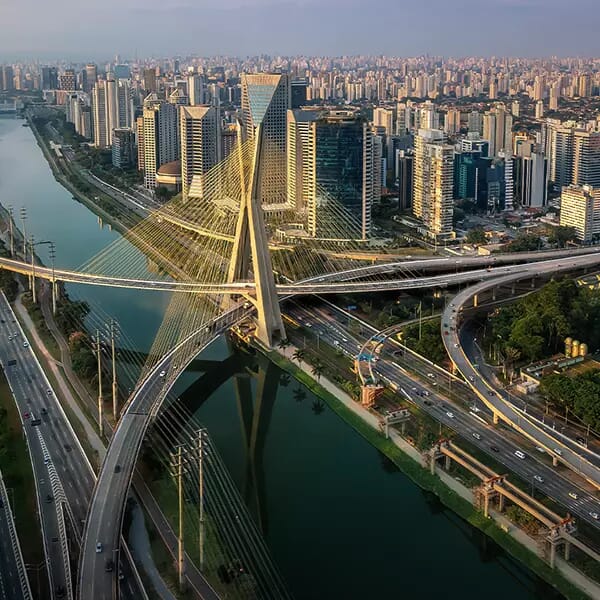 Crédito: Alberto Ruy/ Ministério da Infraestrutura do Brasil
Crédito: Alberto Ruy/ Ministério da Infraestrutura do BrasilIDB makes indications to promote contributions in Latam
An IDB, IDB Invest and Marsh & McLennan Insights study covers contributions in infrastructure and future potential.
July 11, 2019Infrastructure
Considered essential to the development of Latin America and the Caribbean, private investments in infrastructure have been far from ideal in the region in recent years. To get an idea, in 2015, contributions made locally added up to only 2.8 percent of the regional GDP, far below the 5.8 percent of East Asia and the Pacific, according to a report issued by the Inter-American Development Bank (IDB), IDB Invest, and Marsh & McLennan Insights. Although the outlook is stable and private investment prospects are favorable for 2019, the document warns that meeting expectations depends on “decisive actions taken by the region’s new governments and leaders.”
“After a series of political shakeups, the region’s new regimes are taking active steps to address their problems of corruption, win back confidence and restore promising pipelines of infrastructure projects for investors,” said the report, which also highlights measures taken to strengthen the transparency and independence of political and financial institutions.
The analysis, titled ‘Bankability through the lens of transparency,’ released in June, presents a panorama of Brazil, Mexico, Colombia, Peru, Chile, and Argentina – considered the six largest investment markets in infrastructure in the region in the post-Lava Jato investigation period, from 2016 to the present.
Study goals include assessments of potential private investments in the region, of transparency mechanisms, and of initiatives undertaken by the governments of the countries analyzed.
In this context, at the heart of the investigations, Brazil can be held responsible for part of this decline, since the country “comprised 45 percent of Latin American infrastructure investment over the 2008–2015 period, followed by Mexico, Colombia, Argentina, Peru and Chile." Together, the nations accounted for 87 percent of the investments in the years under review.
Therefore, to restore investments in infrastructure in the region “will therefore require a commitment to addressing the issues raised by corruption and reducing the associated uncertainties in the investment process,” urge the document’s authors.
Another challenge to be overcome is the scarce participation of pension funds in the sector, a problem that could be minimized if regulations and limits on contributions were eased, allowing such investors “to hedge against the region’s inflation risks, as well as diversify their portfolios and invest in long-term assets to match their long-term liabilities.”
"Local pension funds can provide an attractive source of funding for infrastructure investors, particularly as the volatility of the region’s currencies increases the need for local currency funding for projects,” goes on the report.
In 2017, China was the third largest source of foreign direct investment (FDI) in the world, and about 7 percent of that amount was earmarked to the region. In 2018, this share grew to 11.8 percent. “Decisively, the large proportion of Chinese investment in Latin America was directed towards infrastructure projects.”
The study points out that there is potential for this volume to grow due to the beginning of the partnership between the Chinese government and the Latin American countries in the Belt & Road Initiative.
Another point raised is the fact that the same investigations that reduced the appetite for investment in the region gave “an additional impetus to Chinese investments.” “The recent rise of corruption investigations in the region has given additional impetus for Chinese investment,” says the report, exemplifying cases of negotiations and funding in Brazil and Peru.
The report also addresses issues specific to sector development – such as regulations for public-private partnerships (PPPs), project structuring and modeling, and economic challenges, and it provides a selection of important funding and risk solutions available to investors to ensure the bankability of projects in the region.
The business potential in the Latin American infrastructure sector continues under debate, especially with the presence of Chinese players during the fourth edition of the GRI China-Latam Infra Summit & Week 2019.
The conference and week are scheduled for August, in China. Edition highlights include the organization of an additional agenda of strategic meetings and technical visits in Shanghai from the seventh to the ninth. Find more details on the event’s website.
“After a series of political shakeups, the region’s new regimes are taking active steps to address their problems of corruption, win back confidence and restore promising pipelines of infrastructure projects for investors,” said the report, which also highlights measures taken to strengthen the transparency and independence of political and financial institutions.
The analysis, titled ‘Bankability through the lens of transparency,’ released in June, presents a panorama of Brazil, Mexico, Colombia, Peru, Chile, and Argentina – considered the six largest investment markets in infrastructure in the region in the post-Lava Jato investigation period, from 2016 to the present.
Study goals include assessments of potential private investments in the region, of transparency mechanisms, and of initiatives undertaken by the governments of the countries analyzed.
Closing the gaps
According to the United Nations Economic Commission for Latin America and the Caribbean (Eclac), the region would need to invest approximately 5.2 percent of the GDP annually to close the infrastructure gaps. However, after 2014, the report says that the levels of investments in infrastructure by private and public sources in Latin America have declined, which can be "attributed in part to the economic slowdown experienced across the region, but can also be attributed to fallouts relating to corruption."In this context, at the heart of the investigations, Brazil can be held responsible for part of this decline, since the country “comprised 45 percent of Latin American infrastructure investment over the 2008–2015 period, followed by Mexico, Colombia, Argentina, Peru and Chile." Together, the nations accounted for 87 percent of the investments in the years under review.
Therefore, to restore investments in infrastructure in the region “will therefore require a commitment to addressing the issues raised by corruption and reducing the associated uncertainties in the investment process,” urge the document’s authors.
Another challenge to be overcome is the scarce participation of pension funds in the sector, a problem that could be minimized if regulations and limits on contributions were eased, allowing such investors “to hedge against the region’s inflation risks, as well as diversify their portfolios and invest in long-term assets to match their long-term liabilities.”
"Local pension funds can provide an attractive source of funding for infrastructure investors, particularly as the volatility of the region’s currencies increases the need for local currency funding for projects,” goes on the report.
Increase in Chinese investments
On the other hand, the document highlights the increased Chinese participation in the region. In a separate chapter, the report addresses the potential for international alternatives to Chinese capital that have been increasingly found in Latin America.In 2017, China was the third largest source of foreign direct investment (FDI) in the world, and about 7 percent of that amount was earmarked to the region. In 2018, this share grew to 11.8 percent. “Decisively, the large proportion of Chinese investment in Latin America was directed towards infrastructure projects.”
The study points out that there is potential for this volume to grow due to the beginning of the partnership between the Chinese government and the Latin American countries in the Belt & Road Initiative.
Another point raised is the fact that the same investigations that reduced the appetite for investment in the region gave “an additional impetus to Chinese investments.” “The recent rise of corruption investigations in the region has given additional impetus for Chinese investment,” says the report, exemplifying cases of negotiations and funding in Brazil and Peru.
Enabling private investment
The final part of the document features several considerations for investors who aim to operate in the region. Among the points covered, with detailed analyses of each country, are the obstacles that have been overcome, measures taken towards transparency and governance, and the improvement of the environment after the elections, especially in Brazil – where voting took place in 2018 and was won by Jair Bolsonaro.The report also addresses issues specific to sector development – such as regulations for public-private partnerships (PPPs), project structuring and modeling, and economic challenges, and it provides a selection of important funding and risk solutions available to investors to ensure the bankability of projects in the region.
GRI China-Latam Infra Summit & Week 2019

The business potential in the Latin American infrastructure sector continues under debate, especially with the presence of Chinese players during the fourth edition of the GRI China-Latam Infra Summit & Week 2019.
The conference and week are scheduled for August, in China. Edition highlights include the organization of an additional agenda of strategic meetings and technical visits in Shanghai from the seventh to the ninth. Find more details on the event’s website.



